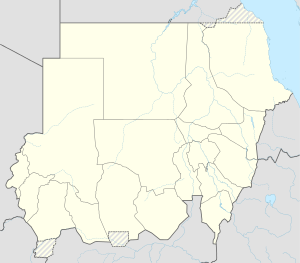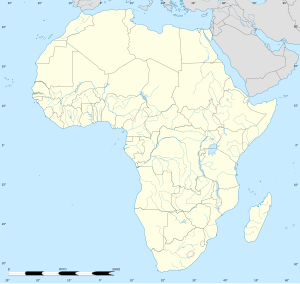Bir Tawil
Bir Tawil
بير طويل | |
|---|---|
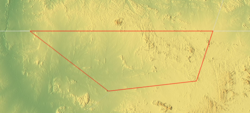 Topographic map of Bir Tawil (outlined in red) | |
| Coordinates: 21°52′9″N 33°44′52″E / 21.86917°N 33.74778°E | |
| Country | None |
| Area | |
• Total | 2,060 km2 (800 sq mi) |
| Population (2018) | |
• Total | 0 |
| Transient populations only[1] | |
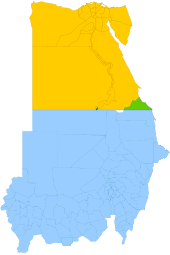
Bir Tawil (Template:Lang-arz, [biːɾ tˤɑˈwiːl]) is a 2,060 km2 (795.4 sq mi) area of land along the border between Egypt and Sudan, which is uninhabited and claimed by neither country. When spoken of in association with the neighbouring Halaib Triangle, it is sometimes referred to as the Bir Tawil Triangle, despite the area's quadrilateral shape; the two "triangles" border at a quadripoint.
Its terra nullius status results from a discrepancy between the straight political boundary between Egypt and Sudan established in 1899, and the irregular administrative boundary established in 1902. Egypt asserts the political boundary, and Sudan asserts the administrative boundary, with the result that the Hala'ib Triangle is claimed by both and Bir Tawil by neither. In 2014, author Alastair Bonnett described Bir Tawil as the only place on Earth that was habitable but was not claimed by any recognised government.[2]
History
On 19 January 1899, an agreement between the United Kingdom and Egypt relating to the administration of Sudan defined "Soudan" as the "territories south of the 22nd parallel of latitude".[3] It contained a provision that would give Egypt control of the Red Sea port of Suakin, but an amendment on 10 July 1899 gave Suakin to Sudan instead.[3]
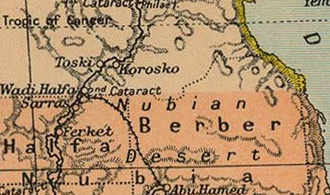
On 4 November 1902, the UK drew a separate "administrative boundary", intended to reflect the actual use of the land by the tribes in the region.[3] Bir Tawil was grazing land used by the Ababda tribe based near Aswan, and thus was placed under Egyptian administration from Cairo. Similarly, the Hala'ib Triangle to the northeast was placed under the British governor of Sudan, because its inhabitants were culturally closer to Khartoum.
Egypt claims the original border from 1899, the 22nd parallel, which would place the Hala'ib Triangle within Egypt and the Bir Tawil area within Sudan. Sudan, however, claims the administrative border of 1902, which would put Hala'ib within Sudan, and Bir Tawil within Egypt. As a result, both states claim Hala'ib and neither claims the much less valuable Bir Tawil area, which is only a tenth the size, and has no permanent settlements or access to the sea. There is no basis in international law for either Sudan or Egypt to claim both territories, and neither nation is willing to cede Hala'ib. With no third state claiming the neglected area, Bir Tawil is one of the few land areas of the world not claimed by any recognised state.[4][5]
Geography
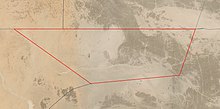
Bir Tawil is 2,060 km2 (795 sq mi) in size. The length of its northern and southern borders are 95 kilometres (59 mi) and 46 kilometres (29 mi) respectively; the length of its eastern and western borders are 26 kilometres (16 mi) and 49 kilometres (30 mi) respectively. In the north of the area is the mountain Jabal Tawil (جبل طويل), with a height of 459 metres (1,506 ft). In the east is Gabal Hagar El Zarqa, with a height of 662 metres (2,172 ft). In the south is the Wadi Tawil (وادي طويل), also called Khawr Abū Bard.
Climate
Bir Tawil's climate is, according to the Köppen climate classification, a very hot desert climate (Bwh). During the summer months, approximately three-quarters of the year, temperatures can exceed 40 °C (104 °F), while its hottest three months (June–August) can see it as high as 45 °C (113 °F). During the brief winters, however (December and January being its mildest months), Bir Tawil can experience milder temperatures, with 26 °C (79 °F) as its usual temperature peak.
Because the territory is far from the ocean (being at least 200 km (120 mi) away from the Red Sea), the diurnal temperature range throughout the region is large, varying from 18 to 20 °C (32 to 36 °F), year-round.[6]
| Climate data for Bir Tawil | |||||||||||||
|---|---|---|---|---|---|---|---|---|---|---|---|---|---|
| Month | Jan | Feb | Mar | Apr | May | Jun | Jul | Aug | Sep | Oct | Nov | Dec | Year |
| Mean daily maximum °C (°F) | 26 (79) |
28 (82) |
32 (90) |
37 (99) |
40 (104) |
42 (108) |
42 (108) |
42 (108) |
41 (106) |
38 (100) |
32 (90) |
27 (81) |
36 (96) |
| Mean daily minimum °C (°F) | 7 (45) |
8 (46) |
11 (52) |
16 (61) |
20 (68) |
22 (72) |
24 (75) |
24 (75) |
22 (72) |
19 (66) |
13 (55) |
9 (48) |
16 (61) |
| Source: MeteoBlue.com[7] | |||||||||||||
Claims
Due to its status as de jure unclaimed territory, a number of individuals and organizations have attempted to claim Bir Tawil as a micronation. However, none have been taken seriously by the international community, and due to the remoteness and hostile climate of the region, the vast majority of these claims have been by declarations posted online from other locations. None of these claims, or any others, have been recognized, officially or otherwise, by any government or international organization.[8][9]
Population
Bir Tawil has no settled population, but members of the Ababda and Bishari tribes pass through the region.[8]
See also
- Egypt–Sudan border
- Egypt–Sudan relations
- Halaib Triangle, an adjoining area, claimed by both Egypt and Sudan
- Wadi Halfa Salient
References
- ^ Karalekas, Dean (2020). "Navigating Terra Nullius: The Ababda and the Case for Indigenous Land Rights in Bir Tawil" (PDF). Global Journal of Economics and Finance. 4 (2): 41–49.
- ^ Bonnett, Alastair (2014). "Bir Tawil". Unruly Places: Lost Spaces, Secret Cities and Other Inscrutable Geographies. Houghton Mifflin Harcourt. p. 73. ISBN 978-0-544-10160-9. LCCN 2013050983. OCLC 890509603.
the only place on the planet that is both habitable and unclaimed.
- ^ a b c "International Boundary Study: Sudan – Egypt (United Arab Republic) Boundary" (PDF). law.fsu.edu. Bureau of Intelligence and Research. 27 July 1962. pp. 2, 3. Archived from the original (PDF) on 13 January 2014. Retrieved 2019-05-28.
- ^ "Official version of map of Egypt". Archived from the original on 2013-05-26. Retrieved 2017-03-05.
- ^ "Egypt". CIA World Factbook. CIA. 2010. ISBN 978-1602397279.
- ^ "Climate: Bir Tawil
- ^ "Weather for Bir Tawil". MeteoBlue.com. Retrieved 6 November 2019.
- ^ a b Shenker, Jack (3 March 2016). "Welcome to the land that no country wants". The Guardian. Retrieved 3 March 2016.
- ^ Ma, Alexandra. "This man is the latest in a series of travellers to declare ownership of a bizarre no man's land in north Africa". Business Insider. Retrieved 2022-08-07.


